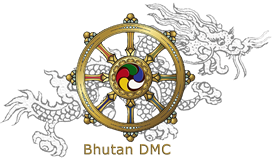The Culture
Having always been politically independent, a rich and distinctive culture developed in the country over the ages. Perhaps the most important single factor in the moulding of Bhutanese character and thought has been the teaching of Lord Buddha, whose eternal truths were first brought into the country from Tibet over the high, snow-bound mountain passes by the great Indian saint, Guru Padmasambhava.
In the Buddhist perspective, culture, tradition and beliefs and the environment are dynamic phenomena that are interwoven tightly in the web of life. As a Buddhist philosopher say, ‘Culture lies not in objects or monuments but in the mind and compassion towards all sentient beings. Bhutan’s unique cultural and traditional values, highly valued in themselves by all the population, are the essential embodiments of the nation’s identity. For a small country located between two most populated countries of the world, India and China, the preservation and promotion of its distinct cultural identity is seen as an important means for its survival as an independent and sovereign Kingdom. It was this identity that has protected and sustained Bhutan and also provided the foundation for its major policies.
Religion Bhutan is the only country in the world to have adopted Mahayana Buddhism in its Tantric form as its official religion. The Buddhist faith has played and continues to play a fundamental role in the cultural, ethical and sociological development of country and its people. Monks are held in great respect and play an active part in community life.
Bhutan is the only country in the world to have adopted Mahayana Buddhism in its Tantric form as its official religion. The Buddhist faith has played and continues to play a fundamental role in the cultural, ethical and sociological development of country and its people. Monks are held in great respect and play an active part in community life.
The influence of Tantric Buddhism since the mid-7th century has irrevocably shaped Kingdom’s history and destiny, and has had an indelible and enlightening impact on the Bhutanese way of life. It affects almost everything, from arts and crafts to the system of government, from folk dances to architectural style. To this day also, the importance and relevance of Buddhism has not waned, and Buddhist values and traditions still permeates every aspect of the Bhutanese culture and ethos.
Architecture
In terms of quality and originality, Bhutanese architecture is without doubt one of the best expressions of country’s unique character. Almost completely isolated for many centuries by its complex geography, Bhutan has indeed seen very few changes in its architectural system since the earliest times. The main roots of its architecture go to Tibet, which was itself in relation with China and faraway Persia, thanks to traders travelling on silk route. Drawing inspiration from older forms and ideas, the architects of Bhutan developed a style which is peculiar to their own country. Displaying a great sense of innovation, they made each dzong, temple and monastery a unique creation, different from all others but at the same time maintaining a perfect unity of architectural style throughout the country. Each of these buildings was designed and built to harmonize with the environment and fulfil certain specific functions and many of them are true master pieces.
Dzongs
The castle-like dzongs, with their gently tapering walls, classic lines, large courtyards and beautiful galleries, are the finest examples of Bhutanese architecture. As well as containing large monasteries, these impressive buildings, set in commanding positions on hilltops or at the confluence of rivers, are also the administrative centre of the region. Reflecting a certain view of religion, society and spatial organization, the dzongs symbolize the history and long independence of Bhutan.
Chortens
The most common architectural sight in Bhutan are the chortens, or stupas, small shrines built originally to house sacred relics. Here the faithful patiently perform the pious act of circumambulation. Some chortens stand close to dzongs or lhakhangs, others appear in remote forest clearings or on mountain passes far from human habitation. Their designs are many, from simple square structures to large, multi-layered, pyramidal shapes. Some are lavishly decorated while others bear only the most rudimentary motifs. All possess an almost indefinable presence, a feeling of peace and serenity.
Lhakhang
Lhakhang (temples) are fairly small building of simple design, seem to have been the first forms of religious architecture. Built in simple design they are likely to comprise one storey around a small, enclosed courtyard and differ from ordinary houses by red band painted on the upper part of their walls and an ornament of gilded copper on the roof. Inside, the walls are completely covered with religious paintings.
Goemba
Bhutanese Goembas (monasteries) can be divided in two types :- ‘Cluster type’ which consists of a core formed by one or two temples with various dwelling structures grouped around such as Dzongdrakha in Paro valley , Phajoding in Thimphu valley and Tharpaling in the Bumthang valley. The second category ‘Dzong type’ is built like fortress with the central tower enclosing the temple and surrounded by exterior walls against which are built monks cells and service rooms. The most impressive example of dzong type goembas are monastery of Gangtey and Tango in upper Thimphu valley.
Village houses
The villages of Bhutan often take the form of small hamlets of between 5 to 15 houses, arranged in such a way as to mitigate the harsher effects of the climate. They are built close together to provide mutual protection against the wind and the cold. Typical Bhutanese houses are found at altitudes of 1000 to 3000 meters. The general pattern is almost same throughout the country.
Religion
Bhutan is the only country in the world to have adopted Mahayana Buddhism in its Tantric form as its official religion. The Buddhist faith has played and continues to play a fundamental role in the cultural, ethical and sociological development of country and its people. Monks are held in great respect and play an active part in community life.
The influence of Tantric Buddhism since the mid-7th century has irrevocably shaped Kingdom’s history and destiny, and has had an indelible and enlightening impact on the Bhutanese way of life. It affects almost everything, from arts and crafts to the system of government, from folk dances to architectural style. To this day also, the importance and relevance of Buddhism has not waned, and Buddhist values and traditions still permeates every aspect of the Bhutanese culture and ethos.
Festivals
At different time of the year, the annual festivals known as ‘Tshechus’ take place in different locations. These Tshechus are festivals extolling the great deeds of Guru Padmasambhava also known as Guru Rinpoche. Festivals are celebrated for several days between three to five and are the occasion for dances that are purely defined in religious content. Dancers in brilliant silk costumes re-enact legendary events, accompanied by blaring horns, booming drums and clashing cymbals as they whirl and leap against a background of sky and mountains. Certain festivals end with the unveiling and worship of a huge religious appliques or ‘thongdroel’ and festival goers believe that simply by viewing this thangkha, they can be delivered from the cycle of reincarnation which is the ultimate aim of Buddhism.
For the Bhutanese people, religious festivals offer an opportunity to become immersed in the meaning of their religion and gain much merit. They are also the occasion for seeing people and for being seen, for social exchanges and for flaunting success. People bring out their finest clothes, their most beautiful jewelleries. An atmosphere of convivial, slightly ribald with humour prevails.
Arts & Crafts
Bhutanese traditional arts and crafts draw upon a long tradition deeply imbued with spiritual significance. This traditional arts and crafts continue to possess its religious and spiritual significance and retain relevance in the minds and lives of the people.
All Bhutanese art, dance, drama and music has its roots in the Buddhist religion. And this Buddhist art has a much different purpose from other contemporary art, being more subjective, symbolic and impersonal. Unlike many other countries, arts, ceremonies and festivals of Bhutan are not remnants of a bygone age but they are still practiced and performed because they continue to have religious and spiritual significance and they are the manifestation of a living culture.
Inspired by their close relationship with nature and their gods, and by the extraordinary scenery of their country, Bhutanese craftsmen have preserved the ancient skills of their ancestors through work in bronze, iron, silver, clay, and wood.
The Bhutanese consider commissioning paintings and statues as pious acts, which gain merit for the patron. Other than its spectacular architecture, the most visible manifestation of Bhutanese art is painting which is defined in three forms: thangkhas, wall paintings and statues.
The country’s primary dance form is the classical lama dancing. All of the dances are religious and symbolize destruction of evil spirits. The most important festival dances celebrate the faith, legends, myths and history of the Kingdom and are important religious and social gatherings.

Among Bhutan’s many hidden treasures is a magical mosaic of rich, vibrant hues and patterns, in myriad weaves. The weaves that have today become vivid symbols of the Dragon Kingdom.
Sports
Archery is the much-loved national sport of Bhutan. Every village has its own archery range, and it is impossible to imagine any festival or special event taking place without a high-spirited archery competition. Contests take place year-round. Targets are made of wood splashed with colourful patterns; the arrow steel tipped.
Many Bhutanese men are skilful archers. The general confidence in their aim is shown by the number of people who stroll unconcernedly near the target during matches – a sight likely to unnerve the visitor.
Other traditional sports include the degor, in which a round, flat stone is thrown at a target, Keshey (wrestling) and pung-do (shotput). In soksom, a spear, held at either end, is thrown at a target, in Khuru the projectile is small, and dart like with a sharp nail at one end and feathers at the other. In sherey parey, a contest of strength, one man grasps the wrist of his opponent, who must free himself in order to win.
Among the legacies of Bhutan’s early contact with the British in India is soccer, a sport which is avidly pursued. Basketball, volleyball, golf, badminton, lawn tennis, table tennis are other popular imports.
Dress
Nowhere is Bhutan’s democratic spirit more readily apparent to the visitor than in the national dress. Men wear a Gho, known in south as Boku, a long robe tied around the waist by a slim belt, or Kera. The folds in the front form a pouch which is used as a pocket, and a cotton or silk vest with broad white cuffs is worn underneath. Formal occasions require men to wear a scarf called Kabney that also indicates person’s rank. Wearing Kabney is an important part of Bhutanese etiquette. The traditional Bhutanese textile is made from fine, hand-woven fabric, with the colourful distinctive patterns.
The women’s ankle-length robe is called, Kira. Made from beautifully coloured, finely woven fabrics – each valley has its own traditional pattern. The Kira is fastened at the waist with a wide Kera and at the shoulder with silver brocades. Women also wear rachu over their left shoulder on all formal occasions.
Language
Bhutan’s official language is Dzongkha, a dialect similar to Tibetan, which has acquired many distinctive national characteristics, particularly in pronunciation. Dzongkha is written in classical Ucan script. Since the sixties, English has been medium of education in secular schools while Choekay, classical Dzongkha, is used in traditional and monastic schools. Nepalese is mainly spoken in southern part of the country.
Given the geographic isolation of many of Bhutan’s highland villages, it is not surprising that a number of different dialects have survived. It is estimated that in eastern Bhutan alone there are as many as eleven vernaculars.
The Way of Life
Still majority of the population of Bhutan continues to live as it has for centuries – in small, isolated farms and hamlets, surrounded by terraced fields of rice, maize and buckwheat. Higher up, many people live in tents woven from yak-hair, spending at least part of the year on the alpine pastures among their grazing livestock. One trait which is common to all Bhutanese is hospitality. Custom dictates that simple hospitality is extended to any and all guests, even to perfect strangers.
In Bhutan, everyone seems to wear a smile. Perhaps this is due to their deep-rooted Buddhist faith or may be their sense of contentment is due to their self-sufficient lifestyle. Whatever the reason, the Bhutanese project an apparent inner happiness that travellers will remember long after their visit.
HOTELS IN THIMPHU
HOTELS IN PUNAKHA & WANGDUE
HOTELS IN GANGTEY
HOTELS IN TRONGSA
HOTELS IN BUMTHANG
HOTELS IN MONGAR
HOTELS IN TRASHIGANG
HOTELS IN SAMDRUP JONGKHAR
HOTELS IN PHUENTSHOLING
HOTELS IN HAA
HOTELS IN GELEPHU
HOTELS IN ZHEMGANG
RESTAURANTS IN PARO
RESTAURANTS IN THIMPHU
RESTAURANTS IN PUNAKHA
TOUR ITINERARIES
TREKKING ITINERARIES
SPECIAL INTERESTS TOURS
UNIQUE FESTIVALS & FAIRS
BLOG


